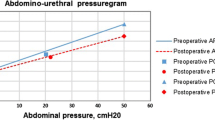Abstract
Introduction and hypothesis
Pelvic organ prolapse (POP) reduction is often performed in the preoperative assessment of women before POP surgery. Using urethral pressure reflectometry (UPR), we sought to investigate how POP reduction affects the urethral closure mechanism.
Methods
Women with anterior or posterior vaginal wall prolapse stage ≥II with and without POP reduction were examined with a speculum. We performed prolapse staging according to the Pelvic Organ Prolapse Quantification system, UPR measurements at rest and during squeezing, and standardized stress tests with 300 ml saline. All examinations were repeated after insertion of a speculum.
Results
We included 38 women: 22 with anterior and 16 with posterior vaginal wall prolapse POP-Q stage ≥II. During POP reduction, resting and squeezing urethral pressures decreased by 2.5 cmH2O (p = 0.007) and 5.1 cmH2O (p < 0.0001), respectively, in all women. During POP reduction, the number of positive stress tests increased from four (18%) to eight (36%) in women with anterior vaginal wall prolapse and from one (6%) to nine (56%) in women with posterior vaginal wall prolapse.
Conclusions
POP reduction decreases urethral pressure, especially during squeezing, and consequently increases the number of positive stress tests. The test itself artificially deteriorates the urethral closure mechanism.

Similar content being viewed by others
References
Richardson DA, Bent AE, Ostergard DR. The effect of uterovaginal prolapse on urethrovesical pressure dynamics. Am J Obstet Gynecol. 1983;146:901–5.
Bergman A, Koonings PP, Ballard CA. Predicting postoperative urinary incontinence development in women undergoing operation for genitourinary prolapse. Am J Obstet Gynecol. 1988;158:1171–5.
Bump RC, Fantl JA, Hurt WG. The mechanism of urinary continence in women with severe uterovaginal prolapse: results of barrier studies. Obstet Gynecol. 1988;72:291–5.
Zivkovic F, Tamussino K, Haas J. Contribution of the posterior compartment to the urinary continence mechanism. Obstet Gynecol. 1998;91:229–33.
Nguyen JN, Yazdany T, Burchette RJ. Urodynamic evaluation of urethral competency in women with posterior vaginal support defects. Urology. 2007;69:87–90. https://doi.org/10.1016/j.urology.2006.09.068.
Myers DL, Lasala CA, Hogan JW, Rosenblatt PL. The effect of posterior wall support defects on urodynamic indices in stress urinary incontinence. Obstet Gynecol. 1998;91:710–4.
Klarskov N. Urethral pressure reflectometry. A method for simultaneous measurements of pressure and cross-sectional area in the female urethra. Dan Med J. 2012;59:B4412.
Khayyami Y, Lose G, Klarskov N. Urethral pressure reflectometry in women with pelvic organ prolapse: a study of reproducibility. Int Urogynecol J. 2016; https://doi.org/10.1007/s00192-016-3187-1.
Klarskov N, Lose G. Urethral pressure reflectometry vs urethral pressure profilometry in women: a comparative study of reproducibility and accuracy. BJU Int. 2007;100:351–6. https://doi.org/10.1111/j.1464-410X.2007.06922.x.
Khayyami Y, Klarskov N, Lose G. The promise of urethral pressure reflectometry: an update. Int Urogynecol J. 2016; https://doi.org/10.1007/s00192-016-2964-1.
Khayyami Y, Lose G, Klarskov N. The urethral closure mechanism is deteriorated after anterior colporrhaphy. Int Urogynecol J. 2017; https://doi.org/10.1007/s00192-017-3504-3.
Khayyami Y, Lose G, Klarskov N. Posterior colporrhaphy does not affect the urethral closure mechanism. Int Urogynecol J. 2017; https://doi.org/10.1007/s00192-017-3401-9.
Haylen BT, Maher CF, Barber MD, et al. An international urogynecological association (IUGA) / international continence society (ICS) joint report on the terminology for female pelvic organ prolapse (POP). Int Urogynecol J. 2016;27:165–94. https://doi.org/10.1007/s00192-015-2932-1.
Schäfer W. Some biomechanical aspects of continence function. Scand J Urol Nephrol Suppl. 2001;207:44–60.
Svenningsen R, Borstad E, Spydslaug AE, et al. Occult incontinence as predictor for postoperative stress urinary incontinence following pelvic organ prolapse surgery. Int Urogynecol J. 2012;23:843–9. https://doi.org/10.1007/s00192-012-1764-5.
Visco AG, Brubaker L, Nygaard I, et al. The role of preoperative urodynamic testing in stress-continent women undergoing sacrocolpopexy: the Colpopexy and urinary reduction efforts (CARE) randomized surgical trial. Int Urogynecol J Pelvic Floor Dysfunct. 2008;19:607–14. https://doi.org/10.1007/s00192-007-0498-2.
Ellström Engh AM, Ekeryd A, Magnusson Å, et al. Can de novo stress incontinence after anterior wall repair be predicted? Acta Obstet Gynecol Scand. 2011;90:488–93. https://doi.org/10.1111/j.1600-0412.2011.01087.x.
Wei JT, Nygaard I, Richter HE, et al. A midurethral sling to reduce incontinence after vaginal prolapse repair. N Engl J Med. 2012;366:2358–67. https://doi.org/10.1056/NEJMoa1111967.
Dumoulin C, Hay-Smith EJC, Mac Habée-Séguin G. Pelvic floor muscle training versus no treatment, or inactive control treatments, for urinary incontinence in women. Cochrane Database Syst Rev. 2014;5:CD005654
Ennemoser S, Schönfeld M, von Bodungen V, et al. Clinical relevance of occult stress urinary incontinence (OSUI) following vaginal prolapse surgery: long-term follow-up. Int Urogynecol J. 2012;23:851–5. https://doi.org/10.1007/s00192-012-1765-4.
van der Ploeg J, Oude Rengerink K, van der Steen A, et al. Transvaginal prolapse repair with or without the addition of a midurethral sling in women with genital prolapse and stress urinary incontinence: a randomised trial. BJOG Int J Obstet Gynaecol. 2015;122:1022–30. https://doi.org/10.1111/1471-0528.13325.
van der Ploeg J, van der Steen A, Oude Rengerink K, et al. Prolapse surgery with or without stress incontinence surgery for pelvic organ prolapse: a systematic review and meta-analysis of randomised trials. BJOG Int J Obstet Gynaecol. 2014;121:537–47. https://doi.org/10.1111/1471-0528.12509.
Weber AM. Is urethral pressure profilometry a useful diagnostic test for stress urinary incontinence? Obstet Gynecol Surv. 2001;56:720–35.
Weber AM. Leak point pressure measurement and stress urinary incontinence. Curr Womens Health Rep. 2001;1:45–52.
Saaby M-L, Klarskov N, Lose G. Urethral pressure reflectometry during intra-abdominal pressure increase—an improved technique to characterize the urethral closure function in continent and stress urinary incontinent women. Neurourol Urodyn. 2013;32:1103–8. https://doi.org/10.1002/nau.22368.
Acknowledgments
We thank Nurse Berit Sejersen Larsen for her assistance with all examinations in this study.
Funding
The study was fully funded by the University of Copenhagen, as part of a PhD Scholarship. The University of Copenhagen had no part in the study.
Author information
Authors and Affiliations
Corresponding author
Ethics declarations
Conflicts of interest
Y.K., G.L. and N.K. have received honoraria as investigators from Astellas. G.L. has also been a consultant for Contura.
Additional information
This paper was presented as an abstract at the International Continence Society’s 47th Annual Meeting in Florence, Italy, in September 2017.
Rights and permissions
About this article
Cite this article
Khayyami, Y., Lose, G. & Klarskov, N. Prolapse reduction deteriorates the urethral closure mechanism. Int Urogynecol J 30, 489–493 (2019). https://doi.org/10.1007/s00192-018-3647-x
Received:
Accepted:
Published:
Issue Date:
DOI: https://doi.org/10.1007/s00192-018-3647-x




